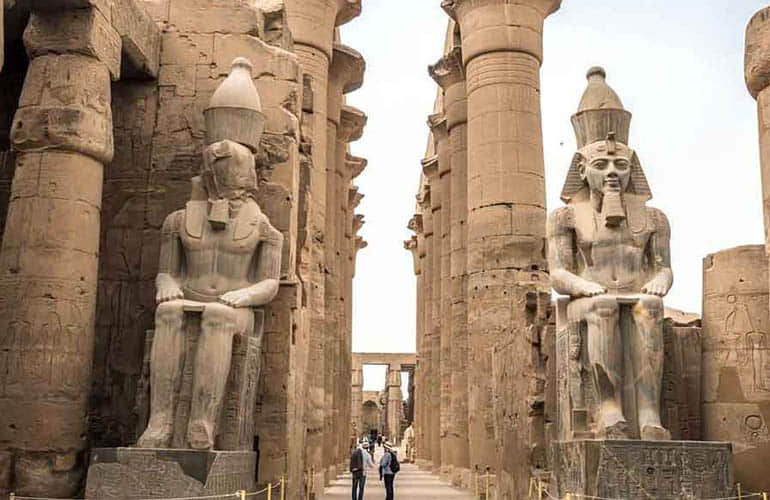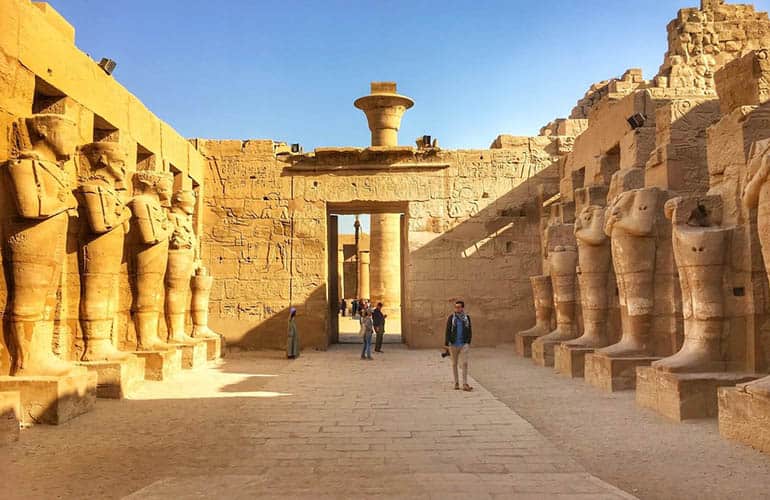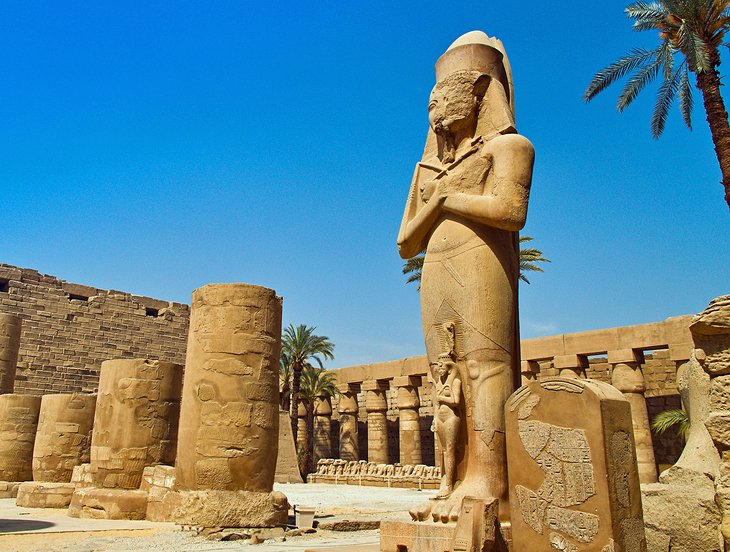Luxor Temple: A Must-Visit for Any Egyptophile

I. Introduction to Luxor Temple
Luxor Temple, located in the city of Luxor in Egypt, is a fascinating historical site that attracts Egyptophiles and history enthusiasts worldwide. This ancient temple holds immense historical significance and offers a captivating insight into ancient Egypt's rich history and cultural heritage.
1. Historical significance
Luxor Temple, also known as The Temple of Amun-Ra, was built during the New Kingdom period of ancient Egypt, around 1400 BCE. It was dedicated to the Theban Triad, consisting of the god Amun-Ra, his consort Mut, and their son Khonsu. This temple played a crucial role in ancient Egypt's religious and political life, serving as a place of worship and a centre for important rituals and festivals.
The temple has witnessed numerous historical events and has been modified and expanded by several pharaohs. It showcases remarkable Egyptian architectural styles, with grand columns, towering obelisks, intricate wall carvings, and imposing statues. The intricate carvings and hieroglyphics on the temple's walls depict scenes from ancient Egyptian mythology, battles, and religious ceremonies, providing a glimpse into the beliefs and daily life of the ancient Egyptians.
2. Location and accessibility
Luxor Temple is conveniently located in the heart of Luxor City, making it easily accessible for tourists. Situated on the east bank of the River Nile, it is just a short distance from other popular attractions, such as the Karnak Temple Complex and the Valley of the Kings.
Visitors can reach Luxor Temple by various means of transportation, including taxis, public buses, or by joining organized tours. The temple is open to the public throughout the year, allowing tourists to explore its magnificent structures and soak in its historical aura.

II. History of Luxor Temple
Ancient Egyptian period
Luxor Temple, also known as "ipet resyt" or "the southern sanctuary," is a monumental ancient Egyptian temple complex located on the east bank of the Nile River in Luxor, Egypt. It was built during the New Kingdom period, around 1400 BC, and dedicated to the Theban god Amun. For many years, the temple served as the religious focal point of Thebes, the capital of Ancient Egypt. Luxor Temple was one of the most important religious and political centres in ancient Egypt and played a significant role in the religious ceremonies and rituals of the pharaohs.
Greek and Roman influence
During the Greek and Roman periods, Luxor Temple underwent modifications and additions by various rulers, including Alexander the Great and Roman Emperor Tiberius. These influences can be seen in the architectural style and decorations of the temple. Greek and Roman gods, such as Zeus and Hercules, were incorporated alongside the Egyptian deities, creating a rich blend of cultural influences.
Rediscovery in modern times
The rediscovery and excavation of the Luxor Temple began in the 19th century with the efforts of French archaeologist Auguste Mariette. The temple was buried under centuries of sand and debris, but it was brought back to its former glory through meticulous excavation and restoration work. Today, Luxor Temple is a testament to ancient Egypt's grandeur and artistic achievements.
Visitors to Luxor Temple can admire various architectural features and decorations, including:
- The massive entrance pylon is flanked by two obelisks, one called Cleopatra's Needle. These obelisks were originally located at the temple entrance, symbolising the pharaoh's power and connection to the gods.
- The Great Court is an open courtyard surrounded by colonnades featuring intricately carved pillars depicting pharaohs and gods.
- The Hypostyle Hall has towering columns and beautifully preserved reliefs of religious scenes.
- The Birth Colonnade is adorned with reliefs depicting the miraculous birth of the divine pharaoh.
A visit to Luxor Temple provides a fascinating glimpse into ancient Egypt's religious beliefs, architectural achievements, and historical significance. It is also a testament to the enduring legacy of this extraordinary civilization, which continues to captivate people worldwide.
Plan your visit to Luxor Temple and immerse yourself in ancient Egypt's rich history and spirituality.

III. Architecture and Design of Luxor Temple
Luxor Temple, located on the east bank of the Nile River in Luxor, Egypt, is a magnificent architectural masterpiece that showcases the grandeur and splendour of the Ancient Egyptian civilization. Built around 1400 BCE, it was dedicated to the rejuvenation of kingship and the worship of the gods Amun-Ra, Mut, and Khonsu. Let's explore the fascinating architecture and design of this historic site.
Main structures and features
-
The Great Court: The entrance to the temple is through the imposing First Pylon, a massive gateway with colossal statues of Ramses II on either side. Beyond the First Pylon lies the Great Court, an impressive open space with rows of colossal columns, some of which are 14 meters high.
-
The Hypostyle Hall is a breathtaking architectural marvel featuring 32 towering columns with intricate carvings and hieroglyphs. The columns are capped with papyrus-shaped capitals, symbolizing Lower Egypt, and lotus-shaped capitals, symbolizing Upper Egypt.
-
The Luxor Obelisk: Rising 25 meters in height, the Luxor Obelisk stands proudly at the temple entrance. Originally, there were two obelisks, but one was gifted to France and now stands in the Place de la Concorde in Paris.
Symbolism and religious significance
-
Rejuvenation of the kingship: Luxor Temple was built to celebrate the annual Opet Festival, during which the ruling pharaoh would undergo a ritual procession from Karnak Temple to Luxor Temple. This procession symbolized the renewal of the pharaoh's divine authority and the life force of Egypt.
-
Triad of Amun-Ra, Mut, and Khonsu: Luxor Temple was dedicated to the worship of these three deities. Amun-Ra, the chief deity, symbolized the sun and the pharaoh's divine authority. Mut, the mother goddess, represented fertility and protection. Khonsu, the moon god, embodied healing and the passage of time.
Decorations and carvings
The walls and columns of Luxor Temple are adorned with intricate carvings and colourful murals that depict important religious and historical scenes. These decorations provide valuable insights into the beliefs, rituals, and daily life of the Ancient Egyptians.
-
The Battle of Kadesh: One of the most famous representations is the Battle of Kadesh, a major conflict between the Egyptian pharaoh Ramses II and the Hittite king Muwatalli II. The reliefs show Ramses II in his chariot, glorifying his victory.
-
The Sacred Marriage: Another notable depiction is the Sacred Marriage scene, which symbolizes the union between the pharaoh and the goddess Mut. This ritual represented the divine connection and the pharaoh's role as an intermediary between the gods and the people.
Luxor Temple is a captivating blend of art, architecture, and religious significance. It's timeless beauty and historical importance make it a must-visit destination for anyone fascinated by Egypt's rich history and culture.
To learn more about Luxor Temple, visit its Wikipedia page for detailed information.

IV. Luxor Temple in Ancient Egyptian Religion
The Luxor Temple is an iconic ancient Egyptian structure with significant religious and cultural importance. Located on the east bank of the Nile River in the city of Luxor, this temple is a must-visit for any Egyptophile. Here are some key points to understand its connection to ancient Egyptian religion.
Connection to Amun-Ra and Karnak Temple
The Luxor Temple is dedicated to the Theban Triad of ancient Egyptian gods - Amun, Mut, and Khonsu. Amun, the supreme god of the ancient Egyptian pantheon, was believed to reside in the temple. The Luxor Temple is also closely linked to the Karnak Temple, located just north of it. Both temples were connected by an avenue of sphinxes, further emphasizing their spiritual and religious significance.
Celebrations and rituals
The Luxor Temple played a vital role in religious celebrations and rituals. It was the setting for the annual Opet Festival, during which Amun, Mut, and Khonsu statues were paraded from the Karnak Temple to the Luxor Temple. This festival was of great importance as it symbolized the marriage between Amun and Mut, and their union was believed to rejuvenate the divine energy of the gods, thus ensuring the continued prosperity of Egypt.
Role in the afterlife beliefs
The Luxor Temple also held significance in ancient Egyptian beliefs about the afterlife. It was believed that after death, the souls of the deceased would travel through the temple complex, ultimately reaching the final judgment hall. The temple's sacred and spiritual aura was thought to facilitate a safe journey for the souls to the afterlife.
In conclusion, the Luxor Temple is a remarkable testament to ancient Egyptian religion and culture. Its connection to Amun-Ra, its role in religious celebrations and rituals, and its significance in beliefs about the afterlife all contribute to its status as a must-visit attraction for those fascinated by ancient Egypt.

V. Luxor Temple: A Must-Visit for Any Egyptophile
In the ancient city of Luxor, Egypt, lies the magnificent Luxor Temple, a site that traces its history back thousands of years. While the temple's origins can be dated to the New Kingdom period of ancient Egypt, it also underwent significant transformations during the Greek and Roman times, resulting in a unique blend of Egyptian, Greek, and Roman architectural styles.
Transformation under the Ptolemies
The Luxor Temple underwent extensive renovations and additions during the reign of the Ptolemaic dynasty, which was of Greek origin. The Ptolemies were passionate about Egyptian culture and wanted to be seen as legitimate pharaohs of Egypt, so they invested heavily in restoring Egypt's ancient temples. The Luxor Temple was no exception and became one of the most important worship centres during this period.
Influences from Greek and Roman gods
As Greek and Roman influences permeated Egyptian society, the Luxor Temple adopted aspects of their pantheon. Greek and Roman gods, such as Zeus, Isis, and Serapis, were worshipped alongside the traditional Egyptian gods like Amun-Ra and Horus. The temple symbolised the fusion of cultures and religions during this period.
Additions and modifications
Under Roman rule, the Luxor Temple saw further modifications and additions. The Romans added their architectural touches, including intricate carvings, statues, and reliefs depicting scenes from their mythology and imperial propaganda. These additions enriched the already stunning complex, making it a showcase of both ancient Egyptian and classical Greco-Roman art and architecture.
The Luxor Temple is known for several remarkable features highlighting the blend of Egyptian, Greek, and Roman influences. The grand entrance, the First Pylon, is adorned with intricate carvings and reliefs depicting prominent pharaohs and gods from different civilizations. The Avenue of Sphinxes, a long road lined with statues of sphinxes, originally connected the Luxor Temple to the Karnak Temple complex.
In conclusion, the Luxor Temple is a testament to the rich history of Egypt and the cultural fusion that occurred over the centuries. Its unique architectural style and blend of religious beliefs make it a must-visit destination for any Egyptophile. Whether you are fascinated by ancient Egyptian history or drawn to the influences of Greek and Roman culture, the Luxor Temple offers a captivating experience that will transport you back in time.
So, make sure to include the Luxor Temple in your itinerary when you visit Egypt and immerse yourself in the awe-inspiring beauty of this ancient wonder.

VI. Highlights of Luxor Temple
If you're a history buff or are fascinated with ancient Egypt, visiting Luxor Temple is an absolute must. This iconic temple is located on the east bank of the Nile River in the city of Luxor and holds immense historical and architectural significance. Here are some of the highlights that make Luxor Temple a must-visit for any Egyptophile:
The Avenue of Sphinxes
One of the most remarkable features of Luxor Temple is the Avenue of Sphinxes, which connects the temple to the Karnak Temple Complex. This avenue stretches over 1.5 kilometres and is lined with statues of sphinxes, mythical creatures with a lion's body and a human head. Walking along this grand avenue is like stepping back in time and experiencing the royal processions that used to take place here.
The Great Court
Upon entering Luxor Temple, visitors are welcomed by the stunning Great Court. This vast courtyard is surrounded by colossal columns and statues, creating a grand, awe-inspiring atmosphere. The Great Court was once used for various religious ceremonies and processions, and its impressive size and architectural beauty leave visitors in awe of the skill and craftsmanship of ancient Egyptian builders.
The Colonnade Hall
One of the most breathtaking sections of Luxor Temple is the Colonnade Hall, also known as the Hypostyle Hall. This hall consists of 14 enormous columns carved with intricate hieroglyphics and depictions of ancient Egyptian gods and pharaohs. The sunlight filtering through the columns creates a magical atmosphere, and visitors can't help but be amazed by this architectural masterpiece's sheer scale and beauty.
The Sanctuary of Alexander the Great
At the heart of Luxor Temple lies the Sanctuary of Alexander the Great, a small chamber added during the Greco-Roman period. Inside the sanctuary, visitors can see a stunning relief of Alexander the Great, who was revered as a pharaoh by the Egyptians. This sanctuary is a testament to Luxor Temple's rich history and the influence of different civilizations that have left their mark on this sacred site.
These are just a few of the many highlights that Luxor Temple has to offer. Whether you're fascinated by ancient history, architectural marvels, or want to immerse yourself in the mystical ambience of ancient Egypt, a visit to Luxor Temple will not disappoint.
For more information on Luxor Temple and its significance in ancient Egyptian history, you can visit this link.

Tips for Visiting Luxor Temple
When planning a trip to Egypt, a visit to Luxor Temple is necessary for any Egyptophile. This ancient temple is located in Luxor, on the east bank of the Nile River. Here are some tips to help you make the most of your visit to Luxor Temple:
Opening hours and ticket prices
- Luxor Temple is open to visitors daily from 6:00 am to 9:00 pm.
- The entrance fee for foreigners is EGP 120 (Egyptian pounds), approximately USD 8.
- It is advisable to arrive early in the morning or late in the afternoon to avoid crowds and enjoy a more peaceful experience.
Dress code and etiquette
- Luxor Temple is a religious site, so it is important to dress modestly and respectfully. Both men and women should cover their shoulders and knees.
- It is recommended to wear comfortable shoes, as a considerable amount of walking is involved within the temple complex.
- Photography is allowed, but asking for permission before taking pictures of individuals or religious rituals is polite.
- Silence is appreciated within the temple, as it is a place of worship and reflection.
